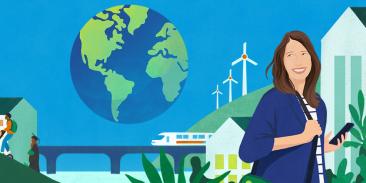4 lies about the Inflation Reduction Act — and how we can fight them
By Lauren Guite

Misinformation about climate change is increasing, and it’s slipperier than ever.
Gone are the days where outright denial was the only problem — and this makes the lies harder to spot. Now, organized groups known as “Bad Actors” are spreading false narratives to cast doubt on climate solutions.
It’s become such a serious threat to the public support needed to solve the climate crisis that the United Nations Intergovernmental Panel on Climate Change called misinformation a threat to climate action for the first time this year.
The explosion in misinformation has inspired the environmental movement — including EDF — to respond in big ways.
As a founding member of a global coalition fighting misinformation, we meet regularly with social media companies to advise on ways to mitigate the spread of climate misinformation.
That work led to Pinterest becoming the first major social media platform to ban content that denies the scientific consensus that climate change is happening and influenced by human activity.
You and I can be part of the solution. As Bad Actors spread false narratives, we can fight for the truth — starting with the Inflation Reduction Act, the most significant climate law Congress has ever passed.
Take action: Join the Anti-Misinformation Brigade
4 lies targeting the Inflation Reduction Act
The Inflation Reduction Act is full of climate solutions that Bad Actors are targeting to mute the impact of this landmark legislation. Here are four priorities under attack:
1. Clean transportation
The truth: The Inflation Reduction will make electric vehicles more affordable than ever while supporting American manufacturing.
Disinformers — those who spread misinformation intentionally — will tell you EVs are only for the elite or that buying them diverts manufacturing to China.
In reality, tax credits and investments in the climate law will make electric vehicles, big and small, more affordable for you and in public transportation, while strengthening the domestic supply chain. The Inflation Reduction Act also requires final assembly in North America to qualify for tax credits.
2. Clean energy
The truth: The climate law includes a game-changing package of incentives, totaling nearly $200 billion, that will ramp up solar and wind power and energy efficiency on the grid.
For years, disinformers have tried to stall climate action by claiming that renewable energy isn’t reliable.
But as the war in Ukraine has proven, the price tag on fossil fuels is volatile. The climate law includes $40 billion in loan authority for innovative energy storage and deployment technologies, which will help make clean energy cheaper and more reliable than ever.
3. Pollution from oil and gas
The truth: The Inflation Reduction Act will create a program to drive down harmful methane emissions from oil and gas operations.
Greenwashers have done their job: A 2021 poll by Climate Nexus shows that 77% of Americans view natural gas, made up almost entirely of methane, as a favorable energy source. When asked about methane, only 29% view it as favorable.
We know that cutting methane emissions is crucial: Methane has more than 80 times the warming power of carbon dioxide over the first 20 years after reaching the atmosphere.
Take action: Join the Anti-Misinformation Brigade
4. Climate-friendly agriculture
The truth: The Inflation Reduction Act makes a historic investment in farmers and rural communities, who are on the front lines of climate change as higher temperatures and changing rainfall make it harder to grow food.
The false narrative that governments that support environmental protections are prioritizing the “green elite” over people’s livelihoods took hold this summer.
But in reality, the Inflation Reduction Act contains nearly $21 billion for climate-friendly agriculture that will help U.S. farmers and rural communities cut emissions and prepare for climate impacts.
How misinformation hacks your brain
The truth takes about six times as long to reach 1,500 people as false stories do. Six. Times. Longer.
And this is from a study that is a few years old, before the global pandemic and the 2020 U.S. election — events that caused an explosion of lies online by Bad Actors.
Research shows that:
- A “familiar” claim, whether credible or not, will seem more true. That means simply repeating something is an effective tactic for climate deniers. The good news is, this works for facts, too.
- Headlines sink in faster when they align with the reader’s worldview. Unsurprisingly, political partisanship contributes to the “stickiness” of a false narrative.
- Sources seen as attractive, powerful and similar to the reader are perceived to be more “credible.” People believe “insiders” more than “outsiders,” which makes the spokesperson an important factor in how a message is perceived.
- Emotional content can distract from the credibility of the message. When people use emotion as information (for example, trust your “gut”), it makes them more susceptible to deception.
How you can fight false climate narratives
At EDF, we’ve implemented a tracking system to monitor and react to the most harmful false narratives. By investigating a suspicious ad, we helped thwart a fake campaign aimed at turning progressives against the climate law.
If you see something fishy, email us to investigate.
We’ve also built a small army of truth tellers, a front line of defense against these myths, called the Anti-Misinformation Brigade.
If you join, you’ll get “Based in Climate Reality,” a monthly email full of helpful tips for spotting and fighting misinformation — like how to use “pre-bunking” to fight EV misinformation or how to talk to a loved one who has heard a lie.










